Ants are among the most common insects in Michigan, found in forests, fields, and even inside homes. While many species are harmless, some are known for their painful bites and aggressive defense of their colonies.
Understanding which ants bite can help you stay safe during outdoor activities or when dealing with infestations around your property. Each species has distinct characteristics that make them easier to identify once you know what to look for.
In this guide, we’ll explore six types of biting ants in Michigan, with detailed descriptions, pictures, and identification tips to help you recognize them and avoid unpleasant encounters.
Types of Biting Ants Found in Michigan
Carpenter Ants (Camponotus spp.)
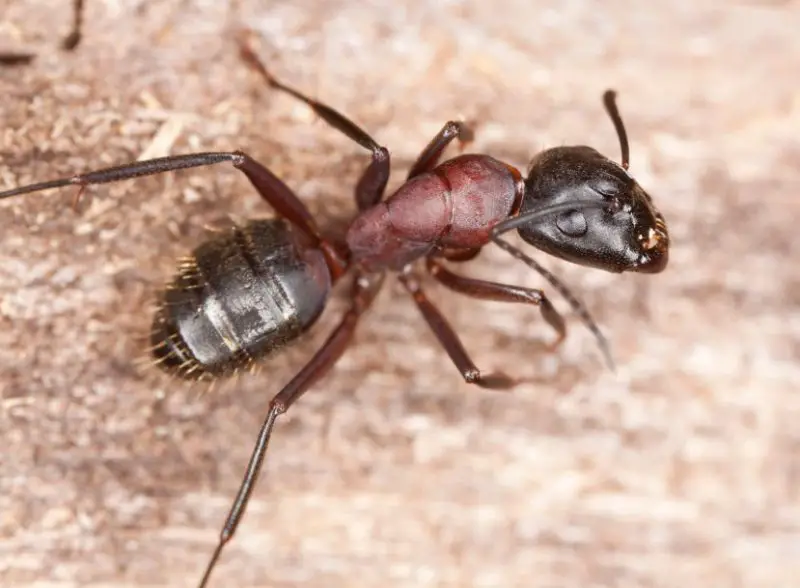
Carpenter ants are among the largest ants found in Michigan, often reaching sizes of ¼ to ½ inch long. They are usually black, though some may have reddish or yellowish hues depending on the species. Their powerful jaws are capable of delivering a painful bite, especially when their nest is disturbed or when they feel threatened. Unlike some ants, carpenter ants do not sting, but they may release formic acid into the wound, which increases the burning sensation.
These ants are best known for their nesting habits inside wood. They do not eat the wood but excavate it to create galleries for their colonies. Over time, this can cause serious structural damage if they establish nests inside houses, sheds, or wooden beams. Because of their ability to weaken wood, carpenter ants are often mistaken for termites, although their biology is quite different.
Carpenter ants are primarily nocturnal foragers, leaving their nests at night to search for food. They feed on sweet substances like honeydew from aphids, as well as proteins from insects or household scraps. When populations grow large, they can establish satellite nests, making them harder to eliminate once an infestation has begun.
In Michigan, carpenter ants are commonly found in wooded areas, around fallen logs, or in damp and decaying wood. Inside homes, they are more likely to infest moist areas such as bathrooms, kitchens, and basements. They are most active in the warmer months and can continue to thrive indoors during colder seasons.
Acrobat Ants (Crematogaster spp.)
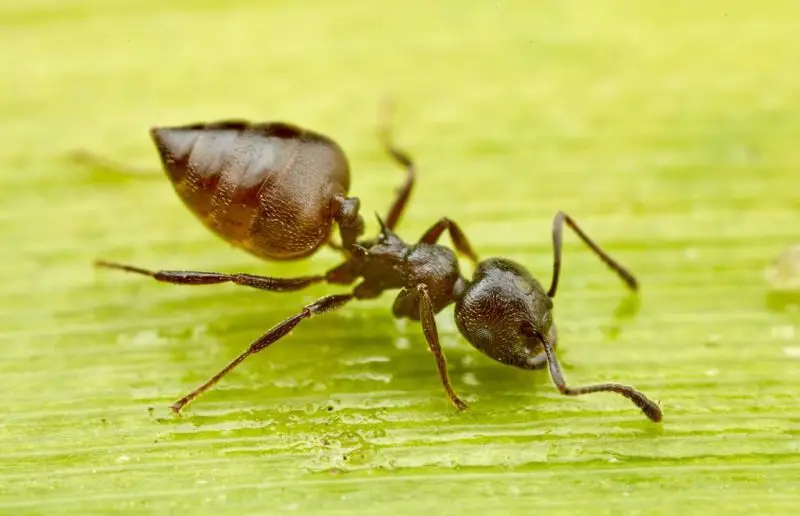
Acrobat ants are small to medium-sized ants that are easily recognized by their unusual posture. When threatened, they raise their heart-shaped abdomen high over their head, resembling an acrobat balancing in the air. This behavior, combined with their aggressive nature, makes them stand out from many other ants in Michigan.
Their bites, though not as painful as those of carpenter ants, can still be irritating, especially if multiple ants attack at once. Acrobat ants are known for being highly defensive of their nests, and they will swarm quickly when disturbed. Along with biting, they can also emit a foul odor as a form of protection.
These ants often nest in rotting wood, hollow trees, under rocks, or even in old carpenter ant galleries. They may also invade homes, particularly when searching for sweets or proteins. Once inside, they are attracted to sugary foods, grease, and even other insects. Their ability to live both outdoors and indoors makes them a persistent nuisance.
In Michigan, acrobat ants are commonly found in wooded areas, around decaying logs, or in moist environments. During warmer months, they can invade homes more frequently, especially when colonies grow too large outdoors. While not considered destructive to wood like carpenter ants, their aggressive behavior and biting habit make them unwanted guests.
Allegheny Mound Ants (Formica exsectoides)

Allegheny mound ants are a striking species native to Michigan, known for the large mounds they build in open fields and forest clearings. Their colonies can contain thousands of workers and expand rapidly, often killing surrounding vegetation by injecting formic acid into nearby plants. These ants are reddish-brown with darker abdomens and can be seen moving in large numbers across their mounds.
They are extremely defensive of their colonies and will bite aggressively when disturbed. In addition to their painful bite, Allegheny mound ants spray formic acid, which can irritate human skin. Their defensive behavior makes them one of the more troublesome ants to encounter in natural areas.
Unlike carpenter ants, these ants are outdoor specialists and rarely enter homes. They feed on honeydew, live insects, and other small arthropods. Their foraging trails can be seen extending long distances from their mounds, and their colonies are capable of lasting for many years if undisturbed.
In Michigan, Allegheny mound ants are found in meadows, pastures, and forest edges. Their large mounds, sometimes over three feet wide, make them easy to identify. While they do not pose a structural risk to homes, their aggressive biting behavior and ability to alter landscapes make them a species people often want to avoid.
Pavement Ants (Tetramorium spp.)
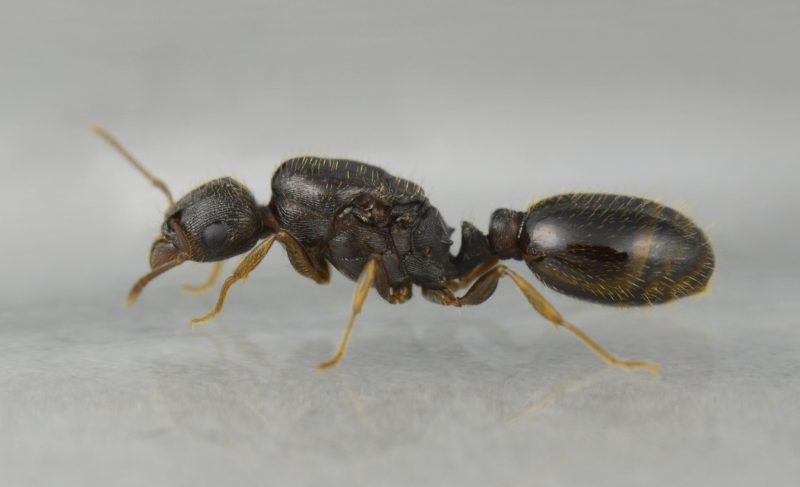
Pavement ants are one of the most common ants in Michigan, often seen around sidewalks, driveways, and foundations. These ants are small, usually about 1/8 inch long, and are dark brown to black in color. They live in cracks of pavement, under stones, and near buildings, which is how they got their name.
Although their bites are not as painful as those of larger species, pavement ants can still nip when they feel threatened. The irritation is usually mild, but because they live so close to human activity, encounters with them are frequent. They are less aggressive than mound or acrobat ants but will still defend their nests when disturbed.
Pavement ants are opportunistic feeders and will scavenge for a wide variety of foods. They prefer greasy and sugary substances, which is why they are often found inside homes, particularly in kitchens. Their colonies can grow very large, and once they establish themselves near a house, they can be difficult to remove.
In Michigan, pavement ants are active during the warm months but can also be a nuisance year-round if they nest indoors. They are commonly found in both urban and suburban environments, making them one of the most frequently encountered biting ants in the state.
Field Ants (Formica spp.)
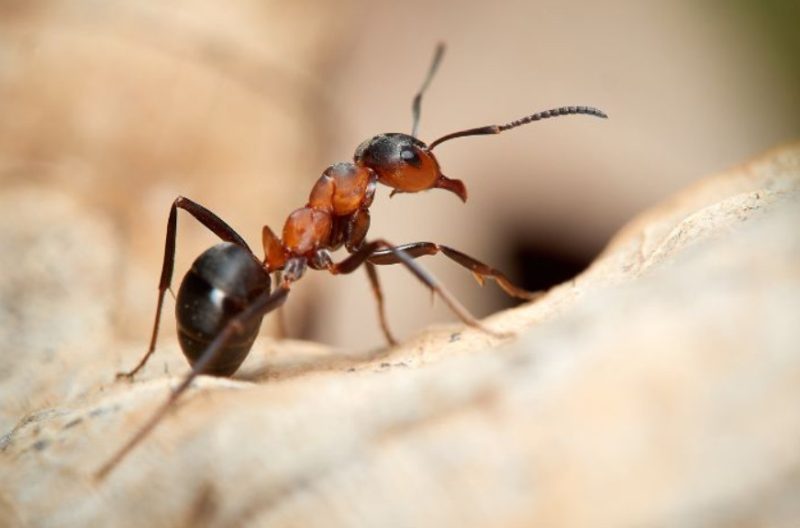
Field ants are another group of biting ants present in Michigan. They are medium to large ants, often red, black, or a combination of both colors. Their colonies are usually located outdoors in lawns, pastures, or forest edges, where they construct soil mounds.
These ants are quick to defend their nests and are known for biting aggressively. Like mound ants, they spray formic acid when they bite, which makes the experience more painful. While they are not dangerous to humans, their large populations and biting habit can make them a nuisance.
Field ants do not typically invade homes but are common in yards and gardens. They feed on honeydew from aphids, as well as insects and plant matter. Their activity can sometimes be beneficial for controlling pest insects, but their bites discourage people from letting them live nearby.
In Michigan, field ants are widespread in rural areas and suburban lawns. Their soil mounds are often mistaken for mole hills or other burrowing animal signs. When disturbed, they swarm quickly, making it easy to get bitten if someone accidentally steps near their nest.
Thief Ants (Solenopsis molesta)
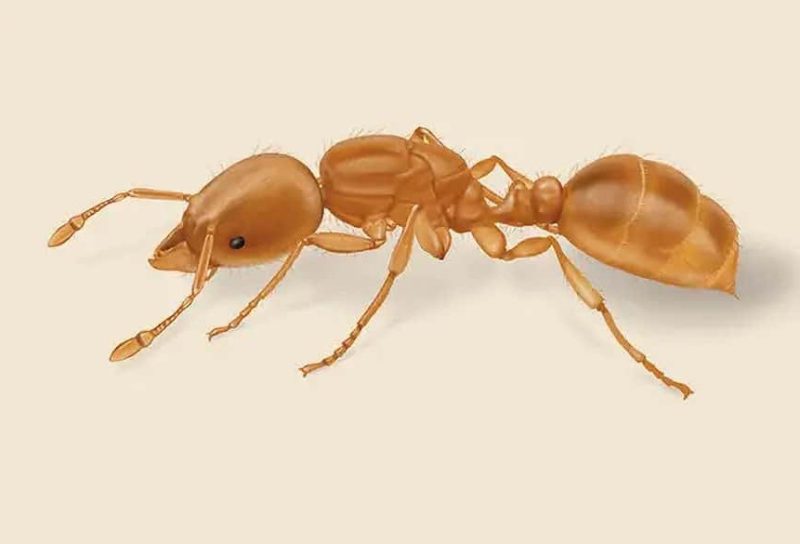
Thief ants are among the smallest ants in Michigan, often measuring less than 1/16 inch in length. Their name comes from their habit of nesting near other ant colonies and stealing food, larvae, or pupae. Despite their small size, they are resourceful and can become persistent pests inside homes.
While their bites are not as painful as those of larger ants, thief ants can still bite when handled or when their nests are disturbed. Because they are so small, their bites often feel like tiny pinches, but in large numbers they can still be irritating.
Thief ants are notorious for their diet, which includes greasy and protein-rich foods. Indoors, they are often drawn to meats, cheese, and oily foods, unlike many other ants that prefer sweets. This makes them particularly difficult to control once they establish colonies inside kitchens.
In Michigan, thief ants are found both outdoors in soil and indoors in cracks and crevices. Their small size allows them to slip into tiny spaces, making infestations challenging to eliminate. While their bite is not dangerous, their persistence and tendency to contaminate food make them unwelcome intruders.
Comparison Table of Biting Ants in Michigan
Ant Species |
Size |
Aggression Level |
Bite Pain |
Common Habitats in Michigan |
|---|---|---|---|---|
Carpenter Ants (Camponotus spp.) |
¼ – ½ inch |
Moderate |
Painful, may spray formic acid |
Damp wood, fallen logs, homes with moisture |
Acrobat Ants (Crematogaster spp.) |
⅛ – ¼ inch |
High |
Mild to moderate, can be irritating |
Rotting wood, under rocks, inside homes |
Allegheny Mound Ants (Formica exsectoides) |
⅛ – ¼ inch |
Very High |
Painful, with strong formic acid spray |
Meadows, forest edges, large soil mounds |
Pavement Ants (Tetramorium spp.) |
~⅛ inch |
Low to Moderate |
Mild bite, mostly nuisance |
Sidewalk cracks, driveways, building foundations |
Field Ants (Formica spp.) |
¼ inch or larger |
High |
Painful, enhanced by formic acid |
Lawns, pastures, forest edges, soil mounds |
Thief Ants (Solenopsis molesta) |
Low |
Very mild, like tiny pinches |
Soil, cracks in buildings, inside kitchens |
How to Prevent Ant Bites in Michigan
Avoiding nests and mounds is the first step to staying safe from biting ants. Many species, such as field ants and Allegheny mound ants, are extremely protective of their colonies and will swarm when disturbed. Pay attention to soil mounds in lawns, forest edges, and meadows, and avoid stepping or digging near them. Educating children about staying away from ant colonies also helps reduce the risk of accidental bites.
Sealing entry points in homes is another key prevention measure. Ants often enter through cracks in foundations, gaps around windows, or poorly sealed doors. Using caulk, weather stripping, and proper insulation can limit their access. By blocking these pathways, you reduce the chances of ants building satellite colonies indoors where bites are more likely to occur.
Keeping food storage secure helps prevent indoor ant problems. Biting ants like carpenter ants, pavement ants, and thief ants are attracted to sugary and greasy foods. Store food in airtight containers, clean up crumbs immediately, and avoid leaving pet food out for long periods. A clean and well-maintained kitchen is far less likely to draw in foraging ants.
Safe outdoor practices include wearing shoes in grassy areas, checking picnic sites for ant activity, and being cautious when working in gardens. Since some ant species bite aggressively when their nests are disturbed, using gloves and protective clothing when gardening reduces direct contact. If an area is heavily infested, consider professional pest control to manage the problem before it worsens.
Conclusion
Michigan is home to several species of biting ants, including carpenter ants, acrobat ants, Allegheny mound ants, pavement ants, field ants, and thief ants. Each species has unique traits, from their nesting habits to the severity of their bites. Understanding these differences makes it easier to identify and manage them effectively.
Correct identification is especially important because some ants are destructive to wood, while others are simply nuisance pests. Knowing which species you are dealing with helps in applying the right control methods and avoiding unnecessary damage to property or risk to health.
In cases of heavy infestations or when aggressive species such as Allegheny mound ants take over a yard, it is best to seek professional pest control. Experts have the tools and knowledge to safely remove ant colonies, protecting both your home and outdoor spaces from further problems.
FAQs about Biting Ants in Michigan
Are there fire ants in Michigan?
Fire ants are not established in Michigan due to the cold climate. However, occasional isolated reports of imported fire ants exist, usually from transported soil or nursery plants. They do not survive long-term in the state.
Which ant bite is the most painful in Michigan?
Allegheny mound ants and field ants generally deliver the most painful bites because they also spray formic acid, which causes additional irritation. Carpenter ants can also deliver a strong bite with their jaws.
Do biting ants in Michigan carry diseases?
No, biting ants in Michigan do not transmit diseases to humans. Their bites can cause pain, redness, and irritation, but they are not known to spread harmful pathogens.
How can I tell the difference between carpenter ants and termites?
Carpenter ants have narrow waists and bent antennae, while termites have straight antennae and thicker waists. Carpenter ants also do not eat wood but excavate it to build nests, unlike termites which consume wood for food.
When should I call a pest control professional for ants?
You should contact pest control if you notice repeated indoor infestations, large colonies near your home, or structural damage caused by carpenter ants. Professional services are also recommended when aggressive mound ants make outdoor spaces unsafe.






